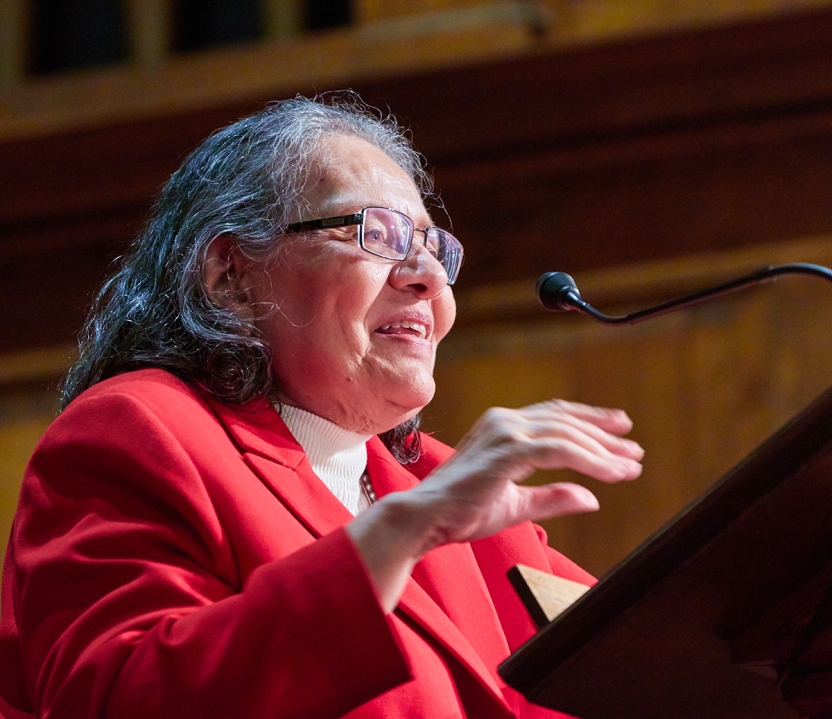Civil Rights Leader Diane Nash Recounts Life at the Forefront of Social Change

MIDDLEBURY, Vt. – When Diane Nash moved to Tennessee as a college student in the late 1950s, the Chicago native encountered segregation as she’d never experienced it before. She bristled at signs that designated “colored” restrooms, and she began noticing how black workers in downtown Nashville had to eat their lunches on the curb, or standing beside the street; they could order food from nearby restaurants but couldn’t sit to eat.
It was degrading and humiliating—and Nash wasn’t one to stand idly by.
Nash became a key figure in the student-led wing of the civil rights movement, overcoming fear of being jailed—or worse—to help coordinate some of the movement’s most successful actions of the 1960s.
The Middlebury College Activities Board brought Nash to campus on April 2 for a talk titled “The Movements of the ’60s: A Legacy for Today.” Nash, 79, spoke of the tactics she and fellow civil rights leaders deployed to challenge and ultimately overturn many racist and segregationist policies. In doing so, she shared the power those same tactics have for activists today fighting entrenched social and economic problems in the United States.
“The only way this country will make it through this period and survive, with citizens having any reasonable measure of rights, is if citizens take the future of this country into our own hands,” said Nash, speaking in Mead Chapel. “Can you imagine if we had waited for elected officials to desegregate lunch counters, buses, and get the right to vote in the South? Now, 50-some years later, we’d probably still be waiting.”
As a student at Fisk University, Nash became the chairwoman of the Nashville Student Movement, training in nonviolent protest and helping to organize the Nashville lunch counter sit-ins that spread to 69 cities across the United States. She was a leader of the Student Nonviolent Coordinating Committee (SNCC) and went on to play integral roles in the 1961 Freedom Rides, the Birmingham desegregation campaign, and the Alabama voting rights campaign of 1965, which culminated in the passage of the Voting Rights Act of 1965.
Her Middlebury lecture came two days before the 50th anniversary of the assassination of Martin Luther King Jr. Nash used the occasion to remind the students in attendance that King, though a great man, wasn’t the sole leader of the civil rights movement; he was the spokesperson.
“We need to realize that there is no one to solve the problems but you and me,” she said.
Nash was born and raised in Chicago. Her first run-ins with Jim Crow laws came in 1959 as a student at Fisk, a historically black college in Nashville, Tennessee.
She started asking fellow students if they knew of any organizations trying to combat segregation. A few classmates warned that she would get into trouble pursuing that goal, but Nash found her way to the workshops organized by James Lawson, a leading theoretician and tactician of nonviolence within the civil rights movement.
That word—“nonviolence”—was never satisfying for Nash and her compatriots, even in the 1960s, she said.
“We really didn’t have a word in English for the process that Gandhi developed,” said Nash. Gandhi had invented a way of waging war with energy produced from love instead of violence. Today she refers to those efforts as “agapic energy” campaigns, a term she coined from one of the four Greek words for love, agape—a form of intense love for mankind.
Loving one’s oppressor is not, Nash acknowledged, a reflex. But for civil rights activists, it made sense on a few levels. Nash and her fellow activists knew that if they met violence with violence they’d be mowed down by police, and that the media would fixate on violence rather than their core messages.
And so the leaders of the civil rights movement looked to Gandhi’s example and trained in the process and principles of nonviolent action. At the heart of the movement were the tenets that people are never the enemy, that oppression always requires the cooperation of the oppressed, and that the only person you can change is yourself.
“When you change yourself, the world has to fit up against the new you,” said Nash. “We in the South changed ourselves into people who could not be segregated. Our position was, shoot us, if that’s what you’re going to do, but you cannot segregate us.”
This is not to say that Nash was not afraid. She was often afraid. She recalled being terrified after her photo ran on the front page of the newspaper during the Nashville sit-ins; outside of one lunch counter protest, an onlooker fingered Nash and said, “That’s Diane Nash. She’s the one to get.” She remembers giving herself 15 minutes to live with and ultimately squelch that fear, and then she carried on with her work.
“Although we had not yet met you,” she said to the audience of primarily students, “we loved you. And we were trying to bring about the best society that we could for you to be born into and come of age in. Future generations are going to need you to do the same for them.”
By Kathryn Flagg; Photo by Todd Balfour

